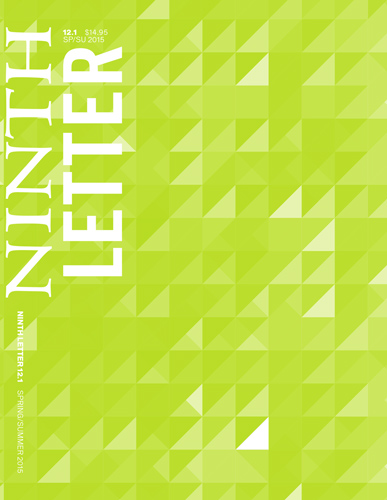Ninth Letter – Spring/Summer 2015
When I first received this issue of Ninth Letter, I was curious to why it came with a box cover. Upon removing it from its sheath, I found that it came with three card inserts, each one a prose piece dedicated either to the waning Dewey decimal system, an immature book defacer, or a “Library of Water.” After reading the prose inserts, I was excited to read further. Once I opened the issue I was greeted by a myriad of art pieces of different sizes, styles, meanings; a smorgasbord of colors and patterns that would take their own review to cover in any detail, which, as a previous art student, I was tempted to write. When I first received this issue of Ninth Letter, I was curious to why it came with a box cover. Upon removing it from its sheath, I found that it came with three card inserts, each one a prose piece dedicated either to the waning Dewey decimal system, an immature book defacer, or a “Library of Water.” After reading the prose inserts, I was excited to read further. Once I opened the issue I was greeted by a myriad of art pieces of different sizes, styles, meanings; a smorgasbord of colors and patterns that would take their own review to cover in any detail, which, as a previous art student, I was tempted to write.
The prose section begins with “Neck Bones” by Ron A. Austin, a captivating story about a young man who uses his late grandmother’s recipes to try and bring his mother and sister together. However, the young man quickly learns that a recipe on a card does not equal his grandmother’s cooking; “Grandma’s cooking was a dark necessary form of alchemy. Her blood thickened the gravy. Her fat fried the fish. She ground her bones to flour, rolled biscuits with her marrow.” The piece features a multiple-choice question for how to kill a goat and the formula for an imperfect daughter, making it difficult to put down.
In “Remains” by Emilia Phillips, the narrator sifts through memories of her father, a forensics expert, and her half-brother who dies from propionic acidemia at a young age. Beginning with a lighter tone, the narrator depicts a time in her life when her father would sweep the house before he deemed it safe to enter, “He becomes a cliché, as all things do to some degree when they’re not witnessed but, rather, imagined.” While the parts about the narrator’s grief can become a little too dramatic, causing me to lose interest at points, the scientific, informative, and story-driven memories and moments are excellently written, engaging definitions in ways I’ve never thought of, and grounding the piece with a strong balance to the grief.
Terrance Manning Jr., in his prose piece “Radio Down,” follows the narrator who accidentally drops a log on his friend/boss’s head, breaking his neck and causing painful past memories to resurface. The tiny details of each character make them come to life, from the sick kid with the lopsided baldhead, and the old “girlfriend” with the scar on her face, to the secret feelings of the main character and his overweight, oversensitive wife: “Street light flickered across her face, turned it orange and black, blinking, her head a porch light bulb turning on and off in the wind.” The narrator does a good job making me dislike the wife (whether intentional or unintentional), and I was pleased to see the ending offer minimal closure.
“Sheep to the Cyclops” by Dawn S. Davies is a snarky and sarcastic piece about the narrator’s experience being:
the kind of pregnant where the baby is crowding your breath and it feels like you are sucking air through a snorkel, where there is no room in your thorax because a human being that is not you, yet is a little bit you, is taking up the room where your guts should be spreading out, relaxing, enjoying the weekend.
The narrator is brutally honest about her experience being pregnant and her relationship with her husband, with whom, she suspects, she will never truly be compatible.
The poetry section, occupying the center of the issue, features two poems by poet Michael Lee. The first one to appear, “The Blade as Key,” explores the different ways things can act as keys, “the way a shovel is a key / to the earth.” Lee’s poem “Secondly. Finally” appears second, digging its claws into grief:
as if this grief could open us,
a skeleton, a screen doora bolt of silk
unraveling. My memory [ . . . ]
By placing “Secondly. Finally” after “The Blade as Key,” it can redefine the key as a type of grief, adding another layer of meaning to the first poem.
In “My Sister Preps Specimens for the Natural History Museum” by Geetha Iyer, the narrator says about her sister, “she couldn’t help feeling as the dead woman’s hands tumbled into her own, // that they were exchanging some message about the things people hold.” As someone who preps specimens for a museum, this line was particularly interesting to me because she holds many things from a chickadee, to a flower mantis, to a gopher tortoise, and so on. The following, final stanza also adds power to this line by showing that the weight of their last memory with their grandmother is something both sisters hold.
With a plethora of art, poems, and a flash fiction piece where elements of Noah’s Ark meet modern day civilization, this issue of Ninth Letter is sure to keep readers busy over the lazy summer days.
[www.ninthletter.com]





